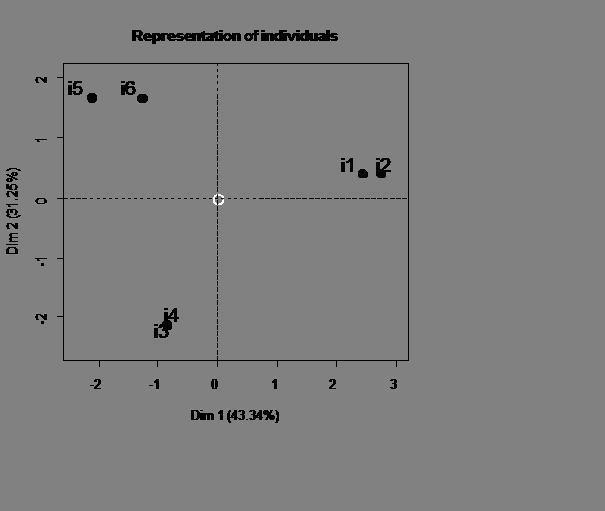 | ||
In statistics, factor analysis of mixed data (FAMD), or factorial analysis of mixed data, is the factorial method devoted to data tables in which a group of individuals is described both by quantitative and qualitative variables. It belongs to the exploratory methods developed by the French school called Analyse des données founded by Jean-Paul Benzécri.
Contents
The term mixed refers to the simultaneous presence, as active elements, of quantitative and qualitative variables. Roughly, we can say that FAMD works as a principal components analysis (PCA) for quantitative variables and as a multiple correspondence analysis (MCA) for qualitative variables.
Scope
When data include both types of variables but the active variables being homogeneous, PCA or MCA can be used.
Indeed, it is easy to include supplementary quantitative variables in MCA by the correlation coefficients between the variables and factors on individuals (a factor on individuals is the vector gathering the coordinates of individuals on a factorial axis); the representation obtained is a correlation circle (as in PCA).
Similarly, it is easy to include supplementary categorical variables in PCA. For this, each category is represented by the center of gravity of the individuals who have it (as MCA).
Thus the presence of supplementary variables having a type different from the one of active variable does not pose any particular problem.
When the active variables are mixed, the usual practice is to perform discretization on the quantitative variables (e.g. usually in surveys the age is transformed in age classes). Data thus obtained can be processed by MCA.
This practice reaches its limits:
Criterion
The data include
In the PCA of
In MCA of Q, we look for the function on
In FAMD
In this criterion, both types of variables play the same role. The contribution of each variable in this criterion is bounded by 1.
Plots
The representation of individuals is made directly from factors
The representation of quantitative variables is constructed as in PCA (correlation circle).
The representation of the categories of qualitative variables is as in MCA : a category is at the centroid of the individuals who possess it. Note that we take the exact centroid and not, as is customary in MCA, the centroid up to a coefficient dependent on the axis (in MCA this coefficient is equal to the inverse of the square root of the eigenvalue; it would be inadequate in FAMD).
The representation of variables is called relationship square. The coordinate of qualitative variable
Aids to interpretation
The relationship indicators between the initial variables are combined in a so-called relationship matrix that contains, at the intersection of row
Example
A very small data set (Table 1) illustrates the operation and outputs of the FAMD . Six individuals are described by three quantitative variables and three qualitatives variables. Data were analyzed using the R package function FAMD FactoMineR .
In the relationship matrix, the coefficients are equal to
The matrix shows an entanglement of the relationships between the two types of variables.
The representation of individuals (Figure 1) clearly shows three groups of individuals. The first axis opposes individuals 1 and 2 to all others. The second axis opposes individuals 3 and 4 to individuals 5 and 6.
The representation of variables (relationship square, Figure 2) shows that the first axis (
This example illustrates how the FAMD simultaneously analyses of quantitative and qualitative variables. Thus, it shows, in this example, a first dimension based on the two types of variables.
History
The FAMD 's original work is due to Brigitte Escofier and Gilbert Saporta. This work was resumed in 2002 by Jérôme Pagès. The most complete presentation of FAMD in English is included in a book of Jérôme Pagès.
